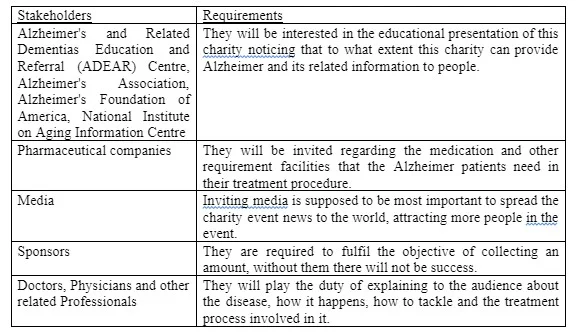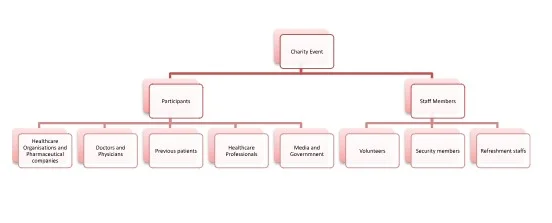Empowering Minds
Event Rationale
Preparing for a charity event proposal plan and managing that from the initiation to its successful ending is quite tough if not done accordingly. The main reason for organising this charity event plan is to make people more aware about each details of this disease and to collect a possible amount of finance which will later be used to support the Alzheimer patients. This rationale will present all those secondary data research, stakeholders’ analysis regarding the charity event & defining the objectives of an event proposal plan which includes the research methodologies, research tools and research techniques relevant to the proposal of the Alzheimer's charity event plan. This charity event proposal is targeted towards the people who are suffering from Alzheimer's disease, which in simple language, is a major progressive neurologic disorder that causes the brain of that person having Alzheimer to shrink (atrophy) and also sometimes causes the brain cells to die in worst conditions (Panza et al. 2019). This charity organisation has been essential since many healthcare researches have presented their report where it has been found that the rate of Alzheimer patients is quite increasing in number, day by day. The charity amount collected from this event will be utilised for the purposes of their treatment, medicines and other facilities for memory loss and confusion, the two primary symptoms. For those researching healthcare dissertation help, managing such events involves careful planning, community engagement, and effective fundraising strategies.
Research Rationale
The rationale explains that the main reason behind preparing this proposal of Alzheimer's charity event plan is to identify the inner details of the Alzheimer's disease and about the patients and how it can be effectively treated with the collected charity amount. The rationale simply contains the preparation of such kind of event with the significance of its success after completion of this charity event.
Stakeholders’ Analysis

In order to make this charity event regarding Alzheimer's a success, huge amount of support in various forms from different types of organisations is needed (US National Library of Medicine, National Institutes of Health, 2018). The aim of this Alzheimer's charity event project is to get more & more of the key stakeholders who will get involved in this project plan to make this event think and look through the organisational processes and create different innovative & new evaluation plans for making it a successful project. Some of the prominent stakeholders engaged in this charity event are like:

Event Objective
The primary objective of this proposed event is to aiming to find a cure for Alzheimer and all the midlife vascular risk factors Alzheimer and also the risk of incident dementia along with that since Alzheimer and Dementia are closely related to each other (Jack et al. 2018). Some of the prominent objectives of this charity event are –
Discussing about discovering some technological help and facilities to treat and cure this disease more quickly and effectively making it a priority
facilitating advanced researches from round the globe to analyse latest treatments that are implemented in other places
strengthening more engaged sponsorship and membership support
achieving all aims & objectives of Alzheimer's Disease International (ADI)
Event Scope
Concept Description of the charity event proposal
This mission charity will mainly focus on fundraising for the patients having Alzheimer and raising awareness. This event will take place covering all over the big places of UK so that every association related with Alzheimer disease and working for it can be able to join. This charity event will be in the form of a closed room seminar where all the healthcare organisation representatives, the pharmaceutical company members, doctors, physicians, some of the cured patients to share their experiences, volunteers, security personnel, media, other healthcare professionals, and government representatives. The collected funds will later be used for their caring, providing them what medical arrangements they needed, fulfilling all the necessities regarding their treatments. And most importantly this charity event proposal has its prime motive to find a method to cure the Alzheimer disease with the help of top experts and professionals (Prayag et al. 2020).
Product Breakdown Structure
Event design: First of all the audience or demographic population targeting the charity needs to be selected and after that the charity mission and time of the event with a definite and attracting name of the event needs to be set (Schnitker et al. 2020).

Promotional activities: There are so many ways by which one can get involved in a charity event and raise money to help in curing & fighting with Alzheimer and facilitate all the necessities of the Alzheimer patients. The most common is the use of social media apart from hoardings, billboards, pamphlets, brochures and other printed mediums. The promotion on social media can be done by releasing short video clips from the organisers, there can be involved some known healthcare personalities for better impact on the audiences (Rathbone et al. 2019). Other than this, there are many more promotional ideas like printing in newspapers to reach in every hoe and making a buzz in the e-news media about the charity to make more people get interested to join.
Setup activities: Few things are there which makes a charity event successful and worthy, from them one most prominent is the place where the event is being organised. The location matters a lot because the location of any charity event brings its necessary ambience which motivates and encourages people to understand the pain and difficulties of the Alzheimer patients and feel the emotions related with them which makes them fund more and more towards this noble cause. The arrangements like projectors, big screens, speakers, laptops, mikes, markers, sitting arrangements and some refreshment arrangements like food stalls, fun games, magazines and book shelves for reading and extra seats for relaxing in the middle or break time.
Coordination activities: Coordination is the most significant thing to make any charity successful as with the help of the staff members and volunteers only, this event can be made a worthy. Team work and team support is needed to ensure that the fundraising event will promote. There should be real-time and on-going connection between the volunteers and security persons to have proper checking and security of the event.
Event Schedule
Budgeting (Estimating process)
For a charity event project to effectively plan and control a project must be accurate estimating which is the most essential thing in the budgeting process. The proper quality and accuracy of the budget estimation should be the best approximation based on certain elements which can be listed as:
Information available
Time available
Expertise and experience of the estimator
Techniques employed
The project cost can be estimated depending upon different costs considering items like - Direct costs, Indirect costs, Labour costs, Project Team Costs, Transport costs, Materials and equipment costs and Time related costs.
The Direct costs include:
Management costs like event running costs, payments of the staff members; volunteers and administrative staffs
Labour costs like performers, caterers, decorators, ushers and others
Cost of the materials, consumables, and other wastage and scrap items included in the event
Ong (2019) opined that the quality and accuracy of the estimated budget can be continually improved as this charity project can be executed and fabricated with more detailed and accuracy information which becomes available. There are two types to estimate the budget, Top down estimating and Bottom up estimating method. Quick (2020) stated that this classification is mainly depending up on the quality of information which is available and the amount of effort that is put into compiling the estimated budget of that event. The Top down estimating method can be suitable for this charity event. The necessary steps for this are –
Identifying a previous project similar to the current event
Measuring how much both the events are similar in comparison of its factors, and
Calculating the estimate of current vent compared with the previous one
According to Bednarska-Olejniczak and Olejniczak (2017) the total estimate is distributed among these four stages in which the initial stage has 25 per cent of the budget, the second stage of the planning stage takes 10 per cent of the budget, after that the third stage of mobilising and staging takes very less amount of 5 per cent of the budget and the last stage doesn’t have any part from the estimated budget of this event plan.
Schedule Evaluation
The charity event schedule evaluation contains certain evaluation questions as –
Did the event accomplish its purpose?
What went well?
What needs to be improved if the event is held again?
Did attendees seem to enjoy themselves?
Should this event be held again?

After every charity event project, it is necessary to gather all the event project engaged staff members & volunteers who worked for the charity event & who participated other than the staff members and volunteers and all the other key people together to conduct a debriefing procedure (Jamieson et al. 2020). As per Fomina (2021) in simple language, all the members needed to conduct a fundraising charity event evaluation process. According to the opinion of Dowson and Bassett (2018) most importantly finding and analysing all the questions asked and checking whether the answers are achieved after the completion of the charity event or not and if not then how they can be fulfilled successfully in the upcoming next events.
Continue your journey with our comprehensive guide to Employee Relations at Work Conditions.
References
Bednarska-Olejniczak, D. and Olejniczak, J., 2017. Participatory budgeting in Poland–finance and marketing selected issues.
Dowson, R. and Bassett, D., 2018. Event planning and management: principles, planning and practice. Kogan Page Publishers.
Fomina, N., 2021. Creating the Model for Special Event Plan.
Jack Jr, C.R., Bennett, D.A., Blennow, K., Carrillo, M.C., Dunn, B., Haeberlein, S.B., Holtzman, D.M., Jagust, W., Jessen, F., Karlawish, J. and Liu, E., 2018. NIA‐AA research framework: toward a biological definition of Alzheimer's disease. Alzheimer's & Dementia, 14(4), pp.535-562.
Jamieson, M., Cullen, B., Lennon, M., Brewster, S. and Evans, J., 2020. Designing ApplTree: usable scheduling software for people with cognitive impairments. Disability and Rehabilitation: Assistive Technology, pp.1-11.
Ong, C., 2019. Budgeting and Cash Flow Management. Centre for Social Development Asia (CSDA), Department of Social Work, Faculty of Arts & Social Sciences, National University of Singapore.
Panza, F., Lozupone, M., Solfrizzi, V., Watling, M. and Imbimbo, B.P., 2019. Time to test antibacterial therapy in Alzheimer’s disease. Brain, 142(10), pp.2905-2929.
Prayag, G., Mills, H., Lee, C. and Soscia, I., 2020. Team identification, discrete emotions, satisfaction, and event attachment: a social identity perspective. Journal of Business Research, 112, pp.373-384.
Quick, L., 2020. Managing events: real challenges, real outcomes. Sage.
Rathbone, C.J., Ellis, J.A., Ahmed, S., Moulin, C.J., Ernst, A. and Butler, C.R., 2019. Using memories to support the self in Alzheimer's disease. Cortex, 121, pp.332-346.
Schnitker, S., Shubert, J., Houltberg, B. and Fernandez, N., 2020. Bidirectional associations across time between entitativity, positive affect, generosity, and religiousness in adolescents training with a religiously affiliated charity marathon team. International journal of environmental research and public health, 17(3), p.686.
US National Library of Medicine, National Institutes of Health, 2018. Current understanding of Alzheimer’s disease diagnosis and treatment, available at: https://www.ncbi.nlm.nih.gov/pmc/articles/PMC6073093/
- 24/7 Customer Support
- 100% Customer Satisfaction
- No Privacy Violation
- Quick Services
- Subject Experts



